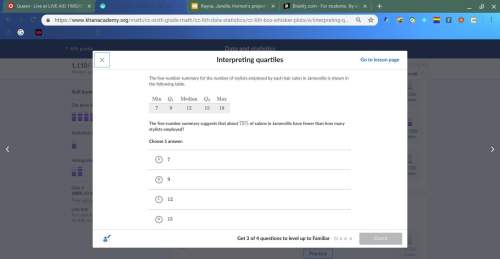
Mathematics, 26.03.2020 16:51 celeste5364
Suppose we use the Naive Bayes model to predict Play (Yes or No) based on two attributes: Temperature and Humidity. Let H denote the event that Play is yes. Let P(H) be the probability that Play is Yes. Let E be the following instance:
Temp Humidity Play
Cool High ?
That is, E denotes (Temp=Cool AND Humidity=High).
Hence, P(E) = P(Temp=Cool AND Humidity=High) is the probability of having cool temp and high humidity.
P(E | H=yes) = P(Temp=Cool AND Humidity=High | H=yes) is the conditional probability of having cool temp. and high humidity given the outcome is Yes.
1) P(E | H=yes) can be computed by P(Temp=Cool | H=yes) * P(Humidity=High | H=yes), i. e. the product of two individual probabilities, only if which of the following (naive) assumption is true?
a. Given the outcome is Yes, Temperature and Humidity are mutually exclusive.
b. Given the outcome is Yes, Temperature and Humidity are dependent.
c. Given the outcome is Yes, Temperature and Humidity are independent.
d. Given the outcome is Yes, Temperature and Humidity are not mutually exclusive.
2) Following the above question, suppose there are 200 instances in the training data:
* 100 instances with outcome Play=yes, among which 20 instances have Temp=Cool, 50 instances have Temp=Mild, 30 instances have Temp=Hot;
* 100 instances with outcome Play=no, among which 50 instances have Temp=Cool, 40 instances have Temp=Mild, 10 instances have Temp=Hot;
What is the conditional probability P(Temp=Cool | H=yes), the probability of having Cool temperature given outcome is Yes?
3) Suppose there are 200 instances in the training data:
* 100 instances with outcome Play=yes, among which 30 instances have Humidity=High and 70 instances have Humidity=Low;
* 100 instances with outcome Play=no, among which 60 instances have Humidity=High and 40 instances have Humidity=Low;
What is the conditional probability P(Humidity=High | H=yes), the probability of having High humidity given outcome is Yes?
4) Given data in the above two questions, what is P(H=yes), the (overall) probability of having outcome Yes?
5) According to Bayes Theorem (rule):
P(H|E) = P(E|H) * P(H) / P(E)
With the above weather data:
P(H=yes | E), i. e. the probability of (predicting) Yes given evidence, can be computed by P(E|H=yes) * P(H=yes) / P(E)
Likewise,
P(H=no | E), i. e. the probability of (predicting) No given evidence, can be computed by P(E|H=no) * P(H=no) / P(E)
Please discuss/answer the following questions:
5.a) How can results from the above questions be used to compute P(H=yes | E) and P(H=no | E)? Show steps and plug in the numbers if you can. Use the Naive Bayes model.
5.b) Discuss whether P(E) matters in the final prediction of Yes vs No. Does it make a difference? Why?

Answers: 1


Another question on Mathematics

Mathematics, 21.06.2019 13:30
Estimate the product. round the first factor to the nearest whole number, round the second factor to the nearest ten, and then multiply. 3 8/9 × 96
Answers: 3

Mathematics, 21.06.2019 20:00
Choose the linear inequality that describes the graph. the gray area represents the shaded region. a: y ≤ –4x – 2 b: y > –4x – 2 c: y ≥ –4x – 2 d: y < 4x – 2
Answers: 2

Mathematics, 22.06.2019 00:30
Will mark ! (10 points also! ) if x varies inversely with y and x =6 when y= 10, find y when x=8 a. y=4.8 b. y=7.5 c. y=40/3 d. y=4/15
Answers: 1

Mathematics, 22.06.2019 01:00
Suppose 38 lbs of coffee beans are required to produce 2 lbs of farmer's coffee. how many lbs of coffee beans are required to produce 309 lbs of farmer's coffee?
Answers: 1
You know the right answer?
Suppose we use the Naive Bayes model to predict Play (Yes or No) based on two attributes: Temperatur...
Questions


Biology, 16.11.2019 22:31



Mathematics, 16.11.2019 22:31


History, 16.11.2019 22:31



Mathematics, 16.11.2019 22:31


Mathematics, 16.11.2019 22:31


History, 16.11.2019 22:31

History, 16.11.2019 22:31

Mathematics, 16.11.2019 22:31

Biology, 16.11.2019 22:31

Biology, 16.11.2019 22:31

Health, 16.11.2019 22:31

History, 16.11.2019 22:31




